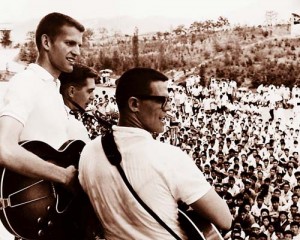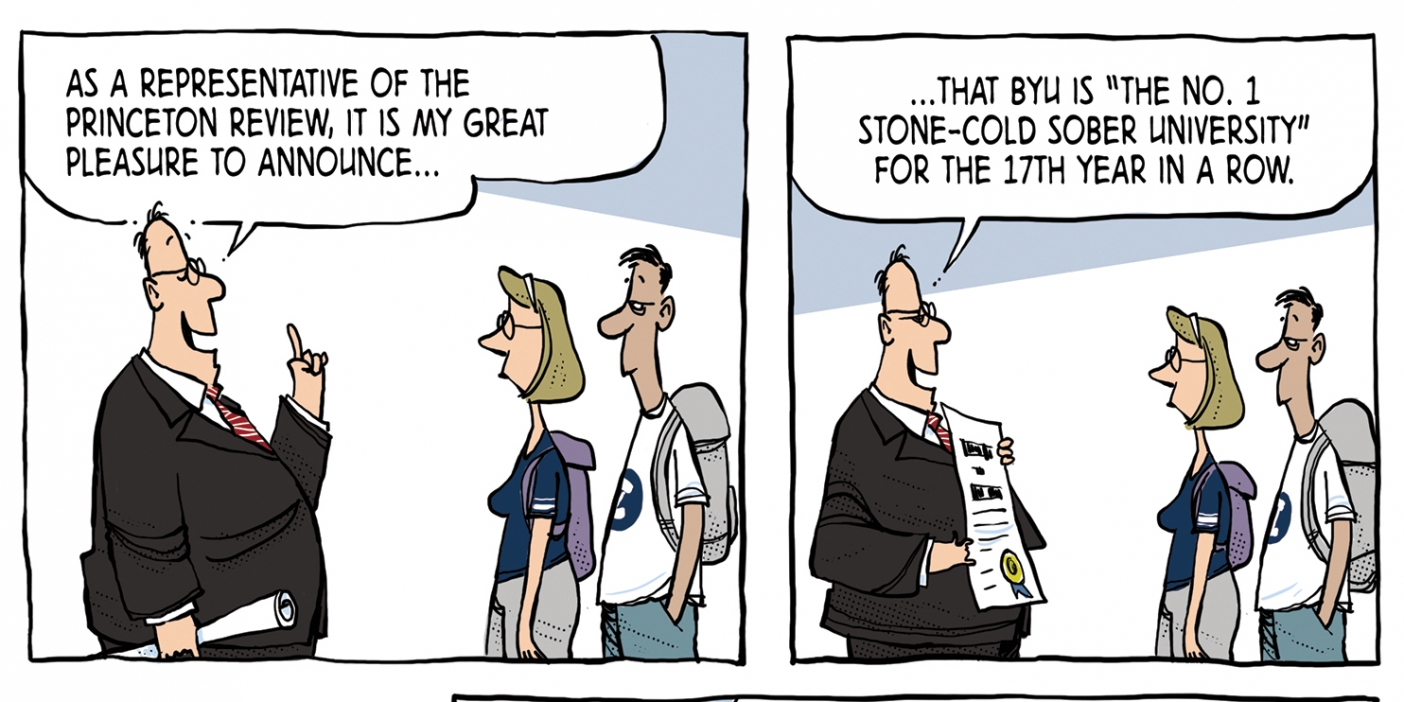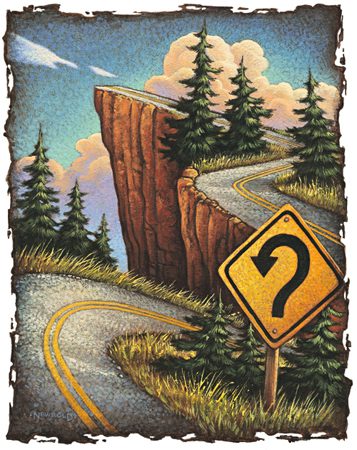
The Three D’s (from left to right) Duane Hiatt, Denis Sorenson, and Dick Davis, entertain an audience during a tour of Asia.
Alumni pull up the curtains on their memories of student performing groups.
After hours upon hours of auditioning, practicing, rehearsing, and finally performing, it’s little wonder that student performers were as affected by what they did as their audiences were. The mix of memories sent in by alumni includes stories of change, adventure, and occasional mishap that occurred in these enterprising students’ quest to entertain.
Music in Memoriam
Clarissa Stolworthy Sorenson, ’60, Salem, Utah
As the wife of Denis S. Sorenson, ’61, of the Three D’s, I have many wonderful memories of those glory days. However, since the terrible events of Sept. 11, I’ve been reminded of another terrible day—Nov. 22, 1963, when President Kennedy was assassinated. The Three D’s were scheduled to be part of a performance in the Smith Fieldhouse that evening. When we heard the news that morning, Denis was immediately concerned about going on stage that night. After it was determined that the show would still go on, all three of the D’s were anxious about the appropriateness of their act. I don’t recall their rehearsal that day, but I remember well the performance.
Understandably, the audience was unresponsive for most of the program that evening; everyone was in a state of shock and dismay. The Three D’s came on near the end and started with some of their regular numbers—with the same deadened result. Then they began a medley of war songs: “Where Have All the Flowers Gone,” “Johnny Has Gone for a Soldier,” and “When Johnny Comes Marching Home Again.” Richard (Dick) C. Davis, ’61, had done his usual unique arrangements, Duane E. Hiatt, ’62, had written a thoughtful and provocative narration, and Denis, as usual, solidified the musical message with his high tenor voice. It was an emotional and much-needed outlet for performers and an audience wanting to grieve. Most of the audience, the Three D’s, and myself were in tears.
The Three D’s went on to a recording contract with Capitol Records and many more performances before Denis left the group, but that night I was more moved by their three-dimensional talent than at any other time.
Laughter, Inc.
Kenneth Q. Craig, ’97, Las Vegas
In December 1992 my roommate and good friend, Lincoln W. Hoppe, ’96, told me about a flyer he had seen in the Wilkinson Center announcing auditions for a comedy troupe that was going to start performing regularly on campus.
Had I known how many good things would come from being a part of the Garrens Comedy Troupe, I would not have mocked Lincoln so quickly for suggesting that he and I audition. Especially when I could have used that energy to mock him for so many other things.
When the original nine of us got together to start practicing, we thought we were hilarious. We were also fairly confident that nobody else would think so.
We practiced and were scheduled to perform in a little theater in the Wilkinson Center that held no more than 100 people. The joke among all of us was that we would one day perform in the Marriott Center, while we were actually unsure if we would ever fill any of the 100 seats there in the Wilkinson Center—I mean with anybody besides our roommates.
The Garrens became bigger than any of us thought it would. We moved to larger rooms to perform; shows regularly sold out; we began performing off campus; and in April 1995, just over three years from when we started, we performed in the Marriott Center.
There is great satisfaction in seeing people laugh and enjoy something that you’ve created, in feeling like one of your talents is appreciated. But more influential to me were the friendships that I came away with. Some of the greatest people I know are people I met in the Garrens. Do I have a favorite? Why, yes. My wife, Katie Fillmore Craig, ’97, who joined the cast in the fall of 1993, decided she would date me in the fall of 1994, and married me in the summer of 1995.
Cool Moves
John V. Parks, ’70, Burke, Va., and Cristen R. Parks, ’69, Bakersfield, Calif.
Our younger brother, Richard M. Parks, ’76, had a natural sense of rhythm and loved modern social dancing to popular music. After two years at Ricks College and a mission to Italy, he came to BYUin 1974 and found that the Y had world-class folk dancers and world-class ballroom dancers but nothing for those who had a talent for the freestyle dance he loved and at which he excelled. So he decided to form such a group. He got a female friend to help, and they started by putting a classified ad in the Daily Universe and posting a few flyers around campus. There was a good response and before long, with nothing but desire, imagination, and time, they were teaching the steps they knew to their little troupe, creating choreographed routines, and having a lot of fun. They soon got some low-profile gigs, which led to bigger ones. Their success did not go unnoticed, and in a year or so, their dance team was absorbed into the Program Bureau. Rick died of pancreatic cancer in 1991, but every time we see BYU show dancers doing those cool moves, we know that the gift Rick eagerly shared at the Y lives on.
Stage Band Follies
Dean W. Fotheringham, ’59, American Fork, Utah
As a member of the Y’s Men stage band, I had some unforgettable experiences. In the late ’50s and early ’60s, we toured a number of areas in the western United States. While performing with the “Happy Holidays” show at the Pasadena Civic Auditorium, one of the female dancers got too close to the band. Her full skirt caught the top of my music stand and tipped it forward. My music shot out onto the stage and the audience. I was so embarrassed sitting there with nothing in front of me. It is a good thing I had my music memorized.
One of the dances required black light, which–when the other lights were off–made anything white glow brightly. When the guys in the band discovered that our teeth would glow, we opened our mouths in unison. This got some laughs but didn’t set too well with Program Bureau leader Janie Thompson or the dancers.
On this tour my friend Gregory D. Farley, ’63; another band member, D. Earl Holt, ’57; and I decided to drive the prop truck. We were to link up with the others in Richland, Wash. Earl had our road map folded on the line between Oregon and Washington. He found Richland, which was 80 miles off the main highway. When we arrived, things just didn’t look right. It was a little town, and there was hardly anyone around. We asked a man if he had seen any Greyhound buses in town. After a brief conversation he said, “Oh, you probably want Richland, Washington. This is Richland, Oregon.” Needless to say, we were very late getting to the right Richland.
After a performance in Seattle, the buses started over a snowy pass to Spokane. We were right behind them until the prop truck started sputtering and coughing, and we turned around and made it back to a tiny, greasy garage owned by a tiny, greasy–but nice–man. After checking the engine, he informed us that it was burned up. With no props and missing three band members, the Spokane show was a little lean. We called the BYU garage, and they said that they would send someone up to tow the truck. We finally did end up on a bus, only this one was headed for Provo.









